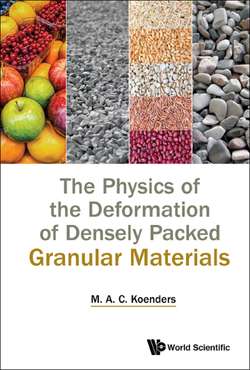The Physics of the Deformation of Densely Packed Granular Materials

Реклама. ООО «ЛитРес», ИНН: 7719571260.
Оглавление
M A C Koenders. The Physics of the Deformation of Densely Packed Granular Materials
Preface
About the Author
Contents
Chapter 1. General Concepts. 1.1Introduction
1.2The isostatic state and jamming
1.3The statically indeterminate case and computer simulations
1.4Contact laws
1.5The frictional interaction
1.5.1Friction in three dimensions
1.6Contact laws in terms of material parameters
1.7Interaction for small particles in a fluid environment
References
Chapter 2. Continuum Mechanics and Cartesian Tensor Calculus. 2.1Initial considerations
2.2Rotations
2.3The strain tensor
2.4The stress tensor
2.5Tensors
2.6Material response
2.7Isotropic materials
2.8Elastic behaviour
2.9Anisotropic materials
2.10Coaxiality
2.11Objectivity and pre-stressed materials, the Jaumann derivative
2.12Frictional materials
References
Chapter3. The Bounds of Static Equilibrium. 3.1Criteria for rupture
3.2The context of second order, partial differential equations
3.3Wave speeds and strong ellipticity
References
Chapter 4. Heterogeneity
Chapter 5. Fabric Description
Chapter 6. Stress-Strain Relations of Granular Assemblies: A Frictionless Assembly. 6.1General considerations
6.2Kinematics
6.3Mean-field approximation
6.4Perturbations to the mean-field theory
6.5Solution in two dimensions
6.6Connectivity in a granular medium
6.7Estimates of the correction to the moduli due to heterogeneity
References
Chapter 7. Stress-Strain Relations of Granular Assemblies: Normal and Tangential Interactions. 7.1Particle spin
7.2The interaction and the quasi-static equilibrium equations
7.3Mean-field stiffness estimate
7.4Heterogeneity with tangential interactions
7.5Solution of the strain fluctuations for a two-dimensional isotropic medium
7.6Considerations for an isotropic contact distribution in two special cases
7.7Anisotropic calculation
7.8A few remarks on the theory
References
Chapter 8. Frictional Granular Materials. 8.1The frictional interaction
8.2Mean-field estimate
8.3Mean-field estimate with randomly distributed slip angles
8.4Mean-field estimate with concentrated slip angles
8.4.1A slip angle associated with the deviatoric stress
8.4.2Further investigation of the slip angle and fabric heterogeneity
8.4.3Verification of the friction criterion
8.5Strain fluctuations
8.5.1Determining the spins
8.5.2The displacement fluctuations associated with a sliding neighbouring particle derived from the force equilibrium equations
8.5.3The stress contribution associated with the fluctuations due to sliding; strain fluctuations and spin fluctuations
8.6Fabric heterogeneity and other refinements
8.7The evolution of an assembly in a biaxial cell test
References
Appendix A. Mathematical Appendix. A.1Isotropic tensors
A.1.1Isotropic 2-tensor
A.1.2Isotropic 4-tensor
A.2Integrals of strings of unit vectors
A.3Elastic constants
A.4Fourier transforms and harmonic density
A.5Bessel functions
A.6Various integrals. A.6.1Integrals involving Bessel functions
A.6.2Integrals with confluent hypergeometric functions
A.6.3Multiple integrals
References
Appendix B. List of Symbols and Notations. B.1List of symbols
B.2List of notations
B.2.1 Structural sums
B.2.2 Other notations
Index
Отрывок из книги
In the early 1980s, the idea first took hold that the mechanical response of a dense granular medium can be understood from a basis of the inter-particle contact properties. The initial efforts, a mean-field theory, had very poor results and papers on ‘micro-mechanics’ were usually relegated to the last section of conference proceedings. Gradually, the insight came about that a granular medium cannot be captured in a mean-field theory and that some form of non-homogeneity in the fabric properties has to be accounted for. The beginnings of this concept were implemented using the available continuum theories on heterogeneity and a few papers came out in the early 90s showing that in certain special cases the mechanical response was captured, but — irritatingly — not all cases. Highly anisotropic packed beds, for example, could not be accounted for and the failure of a granular medium at high stress ratio remained a mystery.
While progress since then has been slow, it is now clear that a proper theory of granular deformation must include a method that deals with heterogeneity that is particularly applicable to a system of particles. This turns out to be the theory of ‘connected media’, which captures the physics of contacting particulates in an appropriate manner. It has also been extended to anisotropic cases. A rigorous approach to Coulomb friction as an inter-particle interaction is required as well. Together these developments can now be implemented with great success.
.....
8.6Fabric heterogeneity and other refinements
8.7The evolution of an assembly in a biaxial cell test
.....